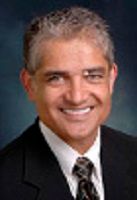Article
Salahuddin Kazi, MD: Drugs, Strategies, Therapies in Rheumatology, MD
Author(s):
Noted rheumatologist reviews research.

Rheumatologists are in short supply in the United States, so internists and primary care physicians often care for patients with rheumatological conditions.
In a talk this morning at the American College of Physicians, Salahuddin Kazi, MD, (photo) a rheumatologist at the University of Texas Southwestern, offered treatment tips, an update on new therapies, and recent research findings.
Herpes zoster infection is a higher risk in patients with autoimmune diseases, and Kazi believes current guidelines set the minimum age for immunizing these patients too high.
“If you cut off at 50 years old or 60, who are you missing?” Kazi said. “Vaccination for herpes zoster will probably benefit patients with autoimmune conditions at younger ages than those stated in the guidelines,” he noted.
Another treatment issue is that of how routinely to use ultrasound to image the joints of patients to see if medications are working. Kazi said it is likely overused.
In the ARTIC trial, he said, 118 patients got ultrasound imaging to examine joints that may have signs of rheumatoid arthritis (RA) and a control group with the condition did not.
The goal was to get patients into remission or low disease activity and the thinking was that ultrasound might find signs of disease in joints that appear normal on visual examination.
In the two-year study, patients in both groups were compared for their rates of remission or near-remission, that is, no swollen joints.
“Ultrasound didn’t matter,” Kazi said, “the curves were nearly identical.”
The group that got regular ultrasound showed a remission rate of 22% and the controls a rate of 19%, an insignificant difference.
The one practice-related difference, he said, was that in the patients getting ultrasound, physicians used more biologic drugs, a pattern that Kazi said is to be generally avoided if possible due to cost considerations.
“If you use ultrasound you are more likely to reach for a biologic because in your mind you’re seeing stuff and want to treat it,” he advised.
The lesson is that “When we reach for a new technology we should look at it through the lens of ‘does it really make a difference?’ and in this case, it did not. “We need ultrasound for joint injections, for guiding the needle, but not for every visit,” he said.
Another way to cut treatment costs may be seen in a done in Sweden where researchers found that with education, patients with an acceptable level of health literacy who have either RA or psoriatic arthritis can learn self-monitoring.
That’s important, he said, because when physicians send patients to a rheumatologist in the US, the specialist generally stabilizes the patient and then has the patient come in every 3 months to monitor medications.
With a US shortage rheumatologists and monitoring the reason for about 80% of patient visits, “Imagine how that could free up schedules,” Kazi said.
When in Sweden researchers looked at whether patients with disease stabilized by DMARDs a group of patients got 2 hours of education in monitoring their conditions and interpreting their own lab values.
Patients self-monitor for other diseases, notably diabetes, he said, so the approach made sense.
It worked, the 52 patients who got training had 54.6% fewer visits over the course of the study.
“This suggests a viable and safe strategy,” he said.
As for promising drugs, Kazi said there is a major need in rheumatology but that there is positive news.
Sifalimumab, an experimental drug that targets interferon alpha, appears to have a therapeutic effect in treating lupus. Interferon alpha is over-expressed in lupus, so targeting it for suppression makes sense.
In a group of 430 lupus patients study results in a year showed modest effective results.
“It appears to be more effective for joint and skin manifestations than for renal, vascular and hematological ones,” he said. Though the study results came with a low predictive value, he is optimistic. “ We need new drugs so I am excited about sifalimumab,” he said.
Statin therapy may also have promise in RA patients.
The condition comes with a higher than normal risk of cardiovascular death, he noted. One UK study found rosuvastatin (Crestor/AstraZeneca) reduced that CV risk by 21%.





